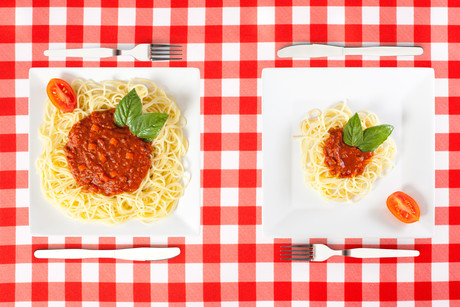Plate diameter and portion size perception

Hungry people identify portion size accurately regardless of the size of the serving plate. This overturns that long-held assumption that if you use smaller diameter plates you will eat less.
With plates and bowls about 23% larger than they were in 1900, it has been tempting to blame the ‘obesity epidemic’ in part on the Delbouef illusion.
The Delbouef illusion predicts people will identify sizes differently when they are placed within a larger or smaller object. The classic experiment shows that people perceive a similar black circle is smaller when it is embedded in a larger circle than when it is embedded in a smaller one.

Translating this into a food analogy: if you put the same size portion onto a smaller diameter plate it will trick the consumer into believing the portion is larger than it actually is.
However, in a new study by Ben-Gurion University of the Negev (BGU), researchers found that when people are food-deprived, they're more likely to identify a portion size accurately, no matter how it is served.
The study, published in Appetite, debunks the popular diet trick based on the Delbouef illusion.
"Plate size doesn't matter as much as we think it does," said Dr Tzvi Ganel, head of the Laboratory for Visual Perception and Action in BGU's Department of Psychology. "Even if you're hungry and haven't eaten, or are trying to cut back on portions, a serving looks similar whether it fills a smaller plate or is surrounded by empty space on a larger one."
The hungrier you are the more accurate you are
In the first study to examine the way food deprivation affects perception of food in different contexts, Dr Ganel and BGU PhD student Noa Zitron-Emanuel found that people who hadn't eaten for at least three hours were more likely to identify the proportions of pizza placed on larger and smaller trays correctly than people who had eaten recently.
Interestingly, this only worked when it applied to food. Both groups were similarly inaccurate when asked to compare the size of black circles and hubcaps placed within different sized circles.
According to the researchers, this indicates that hunger stimulates stronger analytic processing that is not as easily fooled by the illusion.
"Over the last decade, restaurants and other food businesses have been using progressively smaller dishes to conform to the perceptual bias that it will reduce food consumption," said Dr Ganel. "This study debunks that notion. When people are hungry, especially when dieting, they are less likely to be fooled by the plate size, more likely to realise they are eating less and more prone to overeating later."
What's new on the shelf
From classic reinspired ice cream to West African flavours in a jar and whiskey aged in a gaol,...
What's new: six on the shelf
From classic chocolatey flavours reinspired to Korean delicacies, have a look at what's new...
What's new on the shelf?
From Aussie/American fusion-inspired hot sauce to a canned protein drink for gamers, have a look...














